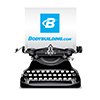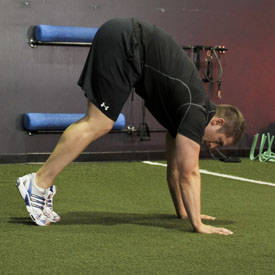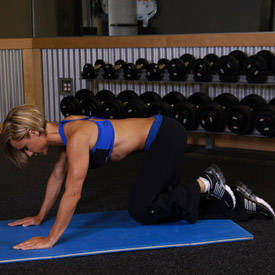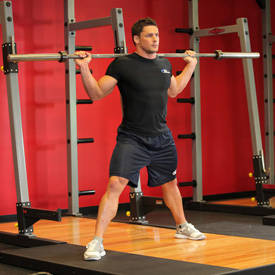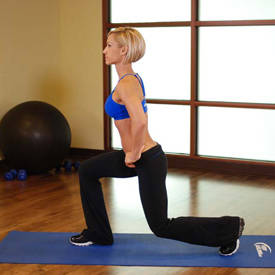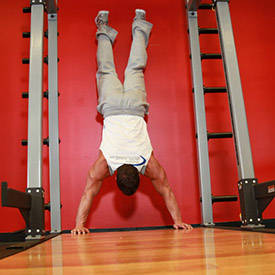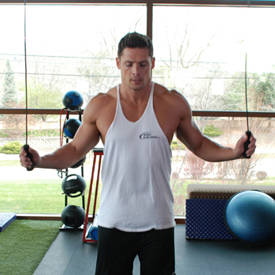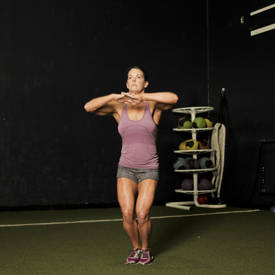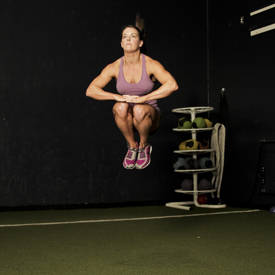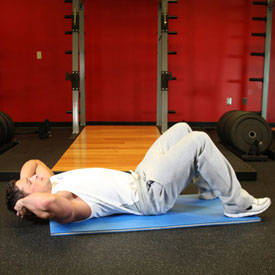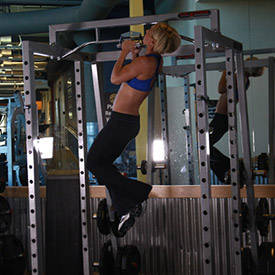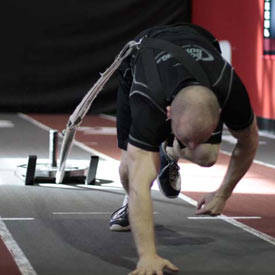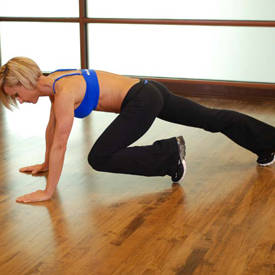
Featured Spartan Exercise
ALL NATURAL

Introducing new, all-natural Pursuit Rx, a line of sports nutritional supplements as hardworking and clean as you are. Developed by an R&D team with over 50 years of industry experience, these efficacious products were made to push you to even faster performance improvement.
- NO ARTIFICIAL FLAVORS OR SWEETENERS
- SOY AND GLUTEN-FREE
- BUILT FOR FUNCTIONAL FITNESS

Previous Spartan Exercises
Inchworm
Exercise Data
|
Type: |
|
|
Main Muscle Worked: |
|
|
Equipment: |
|
|
Mechanics Type: |
|
|
Level: |
|
|
Sport: |
|
|
Force: |
1
Stand with your feet close together. Keeping your legs straight, stretch down and put your hands on the floor directly in front of you. This will be your starting position.
2
Begin by walking your hands forward slowly, alternating your left and your right. As you do so, bend only at the hip, keeping your legs straight.
3
Keep going until your body is parallel to the ground in a pushup position.
4
Now, keep your hands in place and slowly take short steps with your feet, moving only a few inches at a time.
5
Continue walking until your feet are by hour hands, keeping your legs straight as you do so.
Decline Push-Up
Exercise Data
|
Type: |
|
|
Main Muscle Worked: |
|
|
Other Muscles: |
|
|
Equipment: |
|
|
Mechanics Type: |
|
|
Level: |
|
|
Sport: |
|
|
Force: |
1
Lie on the floor face down and place your hands about 36 inches apart while holding your torso up at arms length. Move your feet up to a box or bench. This will be your starting position.
2
Next, lower yourself downward until your chest almost touches the floor as you inhale.
3
Now breathe out and press your upper body back up to the starting position while squeezing your chest.
4
After a brief pause at the top contracted position, you can begin to lower yourself downward again for as many repetitions as needed.
Clock Push-Up
Exercise Data
|
Type: |
|
|
Main Muscle Worked: |
|
|
Other Muscles: |
|
|
Equipment: |
|
|
Mechanics Type: |
|
|
Level: |
|
|
Sport: |
|
|
Force: |
1
Move into a prone position on the floor, supporting your weight on your hands and toes.
2
Your arms should be fully extended with the hands around shoulder width. Keep your body straight throughout the movement. This will be your starting position.
3
Descend by flexing at the elbow, lowering your chest toward the ground.
4
At the bottom, reverse the motion by pushing yourself up through elbow extension as quickly as possible until you are air borne. Aim to “jump” 12-18 inches to one side.
5
As you accelerate up, move your outside foot away from your direction of travel. Leaving the ground, shift your body about 30 degrees for the next repetition.
6
Return to the starting position and repeat the exercise, working all the way around until you are back where you started.
Jackknife Sit-Up
ALSO KNOWN AS: V-UP
Exercise Data
|
Type: |
|
|
Main Muscle Worked: |
|
|
Equipment: |
|
|
Mechanics Type: |
|
|
Level: |
|
|
Sport: |
|
|
Force: |
1
Lie flat on the floor (or exercise mat) on your back with your arms extended straight back behind your head and your legs extended also. This will be your starting position.
2
As you exhale, bend at the waist while simultaneously raising your legs and arms to meet in a jackknife position. Tip: The legs should be extended and lifted at approximately a 35-45 degree angle from the floor and the arms should be extended and parallel to your legs. The upper torso should be off the floor.
3
While inhaling, lower your arms and legs back to the starting position.
4
Repeat for the recommended amount of repetitions.
Variation: If you are really advanced you could use a medicine ball for added resistance.
Air Bike
ALSO KNOWN AS: BICYCLE CRUNCHES
Exercise Data
|
Type: |
|
|
Main Muscle Worked: |
|
|
Equipment: |
|
|
Mechanics Type: |
|
|
Level: |
|
|
Sport: |
|
|
Force: |
1
Lie flat on the floor with your lower back pressed to the ground. For this exercise, you will need to put your hands beside your head. Be careful however to not strain with the neck as you perform it. Now lift your shoulders into the crunch position.
2
Bring knees up to where they are perpendicular to the floor, with your lower legs parallel to the floor. This will be your starting position.
3
Now simultaneously, slowly go through a cycle pedal motion kicking forward with the right leg and bringing in the knee of the left leg. Bring your right elbow close to your left knee by crunching to the side, as you breathe out.
4
Go back to the initial position as you breathe in.
5
Crunch to the opposite side as you cycle your legs and bring closer your left elbow to your right knee and exhale.
6
Continue alternating in this manner until all of the recommended repetitions for each side have been completed.
Notes: While you cannot add resistance to this exercise you can concentrate on perfect execution and slow speed.
Single-Arm Push-Up
ALSO KNOWN AS: ONE-ARM PUSH-UP
Exercise Data
|
Type: |
|
|
Main Muscle Worked: |
|
|
Other Muscles: |
|
|
Equipment: |
|
|
Mechanics Type: |
|
|
Level: |
|
|
Sport: |
|
|
Force: |
1
Begin laying prone on the ground. Move yourself into a position supporting your weight on your toes and one arm. Your working arm should be placed directly under the shoulder, fully extended. Your legs should be extended, and for this movement you may need a wider base, placing your feet further apart than in a normal push-up.
2
Maintain good posture, and place your free hand behind your back. This will be your starting position.
3
Lower yourself by allowing the elbow to flex until you touch the ground.
4
Descend slowly, and reverse direction be extending the arm to return to the starting position.
Plyo Push-up
ALSO KNOWN AS: PLYOMETRIC PUSH-UP
Exercise Data
|
Type: |
|
|
Main Muscle Worked: |
|
|
Other Muscles: |
|
|
Equipment: |
|
|
Mechanics Type: |
|
|
Level: |
|
|
Sport: |
|
|
Force: |
1
Move into a prone position on the floor, supporting your weight on your hands and toes.
2
Your arms should be fully extended with the hands around shoulder width. Keep your body straight throughout the movement. This will be your starting position.
3
Descend by flexing at the elbow, lowering your chest towards the ground.
4
At the bottom, reverse the motion by pushing yourself up through elbow extension as quickly as possible. Attempt to push your upper body up until your hands leave the ground.
5
Return to the starting position and repeat the exercise.
6
For added difficulty, add claps into the movement while you are air borne.
Push Up to Side Plank
Exercise Data
|
Type: |
|
|
Main Muscle Worked: |
|
|
Other Muscles: |
|
|
Equipment: |
|
|
Mechanics Type: |
|
|
Level: |
|
|
Sport: |
|
|
Force: |
1
Get into pushup position on the toes with your hands just outside of shoulder width.
2
Perform a pushup by allowing the elbows to flex. As you descend, keep your body straight.
3
Do one pushup and as you come up, shift your weight on the left side of the body, twist to the side while bringing the right arm up towards the ceiling in a side plank.
4
Lower the arm back to the floor for another pushup and then twist to the other side.
5
Repeat the series, alternating each side, for 10 or more reps.
Push-Up Wide
Exercise Data
|
Type: |
|
|
Main Muscle Worked: |
|
|
Other Muscles: |
|
|
Equipment: |
|
|
Mechanics Type: |
|
|
Level: |
|
|
Sport: |
|
|
Force: |
1
With your hands wide apart, support your body on your toes and hands in a plank position. Your elbows should be extended and your body straight. Do not allow your hips to sag. This will be your starting position.
2
To begin, allow the elbows to flex, lowering your chest to the floor as you inhale.
3
Using your pectoral muscles, press your upper body back up to the starting position by extending the elbows. Exhale as you perform this step.
4
After pausing at the contracted position, repeat the movement for the prescribed amount of repetitions.
Isometric Wipers
Exercise Data
|
Type: |
|
|
Main Muscle Worked: |
|
|
Other Muscles: |
|
|
Equipment: |
|
|
Mechanics Type: |
|
|
Level: |
|
|
Sport: |
|
|
Force: |
1
Assume a push-up position, supporting your weight on your hands and toes while keeping your body straight. Your hands should be just outside of shoulder width. This will be your starting position.
2
Begin by shifting your body weight as far to one side as possible, allowing the elbow on that side to flex as you lower your body.
3
Reverse the motion by extending the flexed arm, pushing yourself up and then dropping to the other side.
4
Repeat for the desired number of repetitions.
Drop Push
ALSO KNOWN AS: PLYOMETRIC PUSH-UP
Exercise Data
|
Type: |
|
|
Main Muscle Worked: |
|
|
Other Muscles: |
|
|
Equipment: |
|
|
Mechanics Type: |
|
|
Level: |
|
|
Sport: |
|
|
Force: |
1
Position low boxes or other platforms 2-3 feet apart.
2
Move to a pushup position between them, supporting yourself by placing your hands on the boxes.
3
With good posture, drop from the platforms by pressing up and moving your hands to shoulder width, cushioning your landing by absorbing the impact through the arm.
Glute Kickback
Exercise Data
|
Type: |
|
|
Main Muscle Worked: |
|
|
Other Muscles: |
|
|
Equipment: |
|
|
Mechanics Type: |
|
|
Level: |
|
|
Sport: |
|
|
Force: |
1
Kneel on the floor or an exercise mat and bend at the waist with your arms extended in front of you (perpendicular to the torso) in order to get into a kneeling push-up position but with the arms spaced at shoulder width. Your head should be looking forward and the bend of the knees should create a 90-degree angle between the hamstrings and the calves. This will be your starting position.
2
As you exhale, lift up your right leg until the hamstrings are in line with the back while maintaining the 90-degree angle bend. Contract the glutes throughout this movement and hold the contraction at the top for a second. Tip: At the end of the movement the upper leg should be parallel to the floor while the calf should be perpendicular to it.
3
Go back to the initial position as you inhale and now repeat with the left leg.
4
Continue to alternate legs until all of the recommended repetitions have been performed.
Variations: For this exercise you can also perform all of the repetitions with one leg first and then the other one. Additionally, you can also add ankle weights.
Incline Push-Up Close-Grip
Exercise Data
|
Type: |
|
|
Main Muscle Worked: |
|
|
Other Muscles: |
|
|
Equipment: |
|
|
Mechanics Type: |
|
|
Level: |
|
|
Sport: |
|
|
Force: |
1
Stand facing a Smith machine bar or sturdy elevated platform at an appropriate height.
2
Place your hands next to one another on the bar.
3
Position your feet back from the bar with arms and body straight. This will be your starting position.
4
Keeping your body straight, lower your chest to the bar by bending the arms.
5
Return to the starting position by extending the elbows, pressing yourself back up.
Body-Up
Exercise Data
|
Type: |
|
|
Main Muscle Worked: |
|
|
Other Muscles: |
|
|
Equipment: |
|
|
Mechanics Type: |
|
|
Level: |
|
|
Sport: |
|
|
Force: |
1
Assume a plank position on the ground. You should be supporting your bodyweight on your toes and forearms, keeping your torso straight. Your forearms should be shoulder-width apart. This will be your starting position.
2
Pressing your palms firmly into the ground, extend through the elbows to raise your body from the ground. Keep your torso rigid as you perform the movement.
3
Slowly lower your forearms back to the ground by allowing the elbows to flex.
4
Repeat.
Star Jump
Exercise Data
|
Type: |
|
|
Main Muscle Worked: |
|
|
Other Muscles: |
|
|
Equipment: |
|
|
Mechanics Type: |
|
|
Level: |
|
|
Sport: |
|
|
Force: |
1
Begin in a relaxed stance with your feet shoulder width apart and hold your arms close to the body.
2
To initiate the move, squat down halfway and explode back up as high as possible. Fully extend your entire body, spreading your legs and arms away from the body.
3
As you land, bring your limbs back in and absorb your impact through the legs.
Double Leg Butt Kick
Exercise Data
|
Type: |
|
|
Main Muscle Worked: |
|
|
Other Muscles: |
|
|
Equipment: |
|
|
Mechanics Type: |
|
|
Level: |
|
|
Sport: |
|
|
Force: |
1
Begin standing with your knees slightly bent.
2
Quickly squat a short distance, flexing the hips and knees, and immediately extend to jump for maximum vertical height.
3
As you go up, tuck your heels by flexing the knees, attempting to touch the buttocks.
4
Finish the motion by landing with the knees only partially bent, using your legs to absorb the impact.
Bicycling
Exercise Data
|
Type: |
|
|
Main Muscle Worked: |
|
|
Other Muscles: |
|
|
Equipment: |
|
|
Mechanics Type: |
|
|
Level: |
|
|
Sport: |
|
|
Force: |
1
To begin, seat yourself on the bike and adjust the seat to your height.
Wear protective gear to avoid possible injury. Ensure that you are courteous to vehicles and pedestrians, and that you obey the rules of the road.
Cycling offers convenience, cardiovascular benefits, and has less impact than other activities. A 150 lb person will burn about 280 calories cycling at a moderate rate for 30 minutes, compared to 450 calories or more running.
Hyperextensions
ALSO KNOWN AS: BACK EXTENSIONS
Exercise Data
|
Type: |
|
|
Main Muscle Worked: |
|
|
Other Muscles: |
|
|
Equipment: |
|
|
Mechanics Type: |
|
|
Level: |
|
|
Sport: |
|
|
Force: |
1
Lie face down on a hyperextension bench, tucking your ankles securely under the footpads.
2
Adjust the upper pad if possible so your upper thighs lie flat across the wide pad, leaving enough room for you to bend at the waist without any restriction.
3
With your body straight, cross your arms in front of you (my preference) or behind your head. This will be your starting position. Tip: You can also hold a weight plate for extra resistance in front of you under your crossed arms.
4
Start bending forward slowly at the waist as far as you can while keeping your back flat. Inhale as you perform this movement. Keep moving forward until you feel a nice stretch on the hamstrings and you can no longer keep going without a rounding of the back. Tip: Never round the back as you perform this exercise. Also, some people can go farther than others. The key thing is that you go as far as your body allows you to without rounding the back.
5
Slowly raise your torso back to the initial position as you inhale. Tip: Avoid the temptation to arch your back past a straight line. Also, do not swing the torso at any time in order to protect the back from injury.
6
Repeat for the recommended amount of repetitions.
Variations: This exercise can also be performed without a hyperextension bench, but in this case you will need a spotter. Also, a similar exercise to this one is the good morning and the stiff-legged deadlift.
Butt Lift (Bridge)
ALSO KNOWN AS: HIP THRUST, GLUTE BRIDGE, BACK BRIDGE
Exercise Data
|
Type: |
|
|
Main Muscle Worked: |
|
|
Other Muscles: |
|
|
Equipment: |
|
|
Mechanics Type: |
|
|
Level: |
|
|
Sport: |
|
|
Force: |
1
Lie flat on the floor on your back with the hands by your side and your knees bent. Your feet should be placed around shoulder width. This will be your starting position.
2
Pushing mainly with your heels, lift your hips off the floor while keeping your back straight. Breathe out as you perform this part of the motion and hold at the top for a second.
3
Slowly go back to the starting position as you breathe in.
Variations: You can perform this exercise one leg at a time.
Arm Circles
Exercise Data
|
Type: |
|
|
Main Muscle Worked: |
|
|
Other Muscles: |
|
|
Equipment: |
|
|
Mechanics Type: |
|
|
Level: |
|
|
Sport: |
|
|
Force: |
1
Stand up and extend your arms straight out by the sides. The arms should be parallel to the floor and perpendicular (90-degree angle) to your torso. This will be your starting position.
2
Slowly start to make circles of about 1 foot in diameter with each outstretched arm. Breathe normally as you perform the movement.
3
Continue the circular motion of the outstretched arms for about ten seconds. Then reverse the movement, going the opposite direction.
Tip: Ten second movements equal one set and each circle equals one repetition.
Variations: As you get stronger you can use some light resistance.
Barbell Side Split Squat
ALSO KNOWN AS: SIDE LUNGES
Exercise Data
|
Type: |
|
|
Main Muscle Worked: |
|
|
Other Muscles: |
|
|
Equipment: |
|
|
Mechanics Type: |
|
|
Level: |
|
|
Sport: |
|
|
Force: |
1
Stand up straight while holding a barbell placed on the back of your shoulders (slightly below the neck). Your feet should be placed wide apart with the foot of the lead leg angled out to the side. This will be your starting position.
2
Lower your body towards the side of your angled foot by bending the knee and hip of your lead leg and while keeping the opposite leg only slightly bent. Breathe in as you lower your body.
3
Return to the starting position by extending the hip and knee of the lead leg. Breathe out as you perform this movement.
4
After performing the recommended amount of reps, repeat the movement with the opposite leg.
Variations: You can perform this movement with dumbbells.
Split Squats
ALSO KNOWN AS: JUMPING LUNGES
Exercise Data
|
Type: |
|
|
Main Muscle Worked: |
|
|
Other Muscles: |
|
|
Equipment: |
|
|
Mechanics Type: |
|
|
Level: |
|
|
Sport: |
|
|
Force: |
1
Being in a standing position. Jump into a split leg position, with one leg forward and one leg back, flexing the knees and lowering your hips slightly as you do so.
2
As you descend, immediately reverse direction, standing back up and jumping, reversing the position of your legs. Repeat 5-10 times on each leg.
Superman
Exercise Data
|
Type: |
|
|
Main Muscle Worked: |
|
|
Other Muscles: |
|
|
Equipment: |
|
|
Mechanics Type: |
|
|
Level: |
|
|
Sport: |
|
|
Force: |
1
To begin, lie straight and face down on the floor or exercise mat. Your arms should be fully extended in front of you. This is the starting position.
2
Simultaneously raise your arms, legs, and chest off of the floor and hold this contraction for 2 seconds. Tip: Squeeze your lower back to get the best results from this exercise. Remember to exhale during this movement. Note: When holding the contracted position, you should look like superman when he is flying.
3
Slowly begin to lower your arms, legs and chest back down to the starting position while inhaling.
4
Repeat for the recommended amount of repetitions prescribed in your program.
Variations: You can also perform this exercise using one arm and leg at a time. Simply elevating your left leg, arm and side of your chest and do the same with the right side.
Handstand Push-Ups
Exercise Data
|
Type: |
|
|
Main Muscle Worked: |
|
|
Other Muscles: |
|
|
Equipment: |
|
|
Mechanics Type: |
|
|
Level: |
|
|
Sport: |
|
|
Force: |
1
With your back to the wall bend at the waist and place both hands on the floor at shoulder width.
2
Kick yourself up against the wall with your arms straight. Your body should be upside down with the arms and legs fully extended. Keep your whole body as straight as possible. Tip: If doing this for the first time, have a spotter help you. Also, make sure that you keep facing the wall with your head, rather than looking down.
3
Slowly lower yourself to the ground as you inhale until your head almost touches the floor. Tip: It is of utmost importance that you come down slow in order to avoid head injury.
4
Push yourself back up slowly as you exhale until your elbows are nearly locked.
5
Repeat for the recommended amount of repetitions.
Caution: Ensure that the floor surface is not slippery and also, if performing for the first time, use a spotter until you get good at this exercise.
Diamond Push-Ups
ALSO KNOWN AS: Push-Ups - Close Triceps Position
Exercise Data
|
Type: |
|
|
Main Muscle Worked: |
|
|
Other Muscles: |
|
|
Equipment: |
|
|
Mechanics Type: |
|
|
Level: |
|
|
Sport: |
|
|
Force: |
1
Lie on the floor face down and place your hands closer than shoulder width for a close hand position. Make sure that you are holding your torso up at arms' length.
2
Lower yourself until your chest almost touches the floor as you inhale.
3
Using your triceps and some of your pectoral muscles, press your upper body back up to the starting position and squeeze your chest. Breathe out as you perform this step.
4
After a second pause at the contracted position, repeat the movement for the prescribed amount of repetitions.
Variations:
1
If you are new at this exercise and do not have the strength to perform it, you can either bend your legs at the knees to take off resistance or perform the exercise against the wall instead of the floor.
2
For the most advanced lifters, you can place your feet at a high surface such as a bench in order to increase the resistance.
Russian Twist
Exercise Data
|
Type: |
|
|
Main Muscle Worked: |
|
|
Other Muscles: |
|
|
Equipment: |
|
|
Mechanics Type: |
|
|
Level: |
|
|
Sport: |
|
|
Force: |
1
Lie down on the floor placing your feet either under something that will not move or by having a partner hold them. Your legs should be bent at the knees.
2
Elevate your upper body so that it creates an imaginary V-shape with your thighs. Your arms should be fully extended in front of you perpendicular to your torso and with the hands clasped. This is the starting position.
3
Twist your torso to the right side until your arms are parallel with the floor while breathing out.
4
Hold the contraction for a second and move back to the starting position while breathing out. Now move to the opposite side performing the same techniques you applied to the right side.
5
Repeat for the recommended amount of repetitions.
Variation: As you get more advanced, you can hold a weight with both arms for resistance.
Single-Arm Push-Up
ALSO KNOWN AS: ONE-ARM PUSH-UP
Exercise Data
|
Type: |
|
|
Main Muscle Worked: |
|
|
Other Muscles: |
|
|
Equipment: |
|
|
Mechanics Type: |
|
|
Level: |
|
|
Sport: |
|
|
Force: |
1
Begin laying prone on the ground. Move yourself into a position supporting your weight on your toes and one arm. Your working arm should be placed directly under the shoulder, fully extended. Your legs should be extended, and for this movement you may need a wider base, placing your feet further apart than in a normal push-up.
2
Maintain good posture, and place your free hand behind your back. This will be your starting position.
3
Lower yourself by allowing the elbow to flex until you touch the ground.
4
Descend slowly, and reverse direction be extending the arm to return to the starting position.
Running
Exercise Data
|
Type: |
|
|
Main Muscle Worked: |
|
|
Other Muscles: |
|
|
Equipment: |
|
|
Mechanics Type: |
|
|
Level: |
|
|
Sport: |
|
|
Force: |
1
Running or hiking on trails will get the blood pumping and heart beating almost immediately. Make sure you have good shoes. While you use the muscles in your calves and buttocks to pull yourself up a hill, the knees, joints and ankles absorb the bulk of the pounding coming back down. Take smaller steps as you walk downhill, keep your knees bent to reduce the impact and slow down to avoid falling.
2
A 150 lb person can burn over 200 calories for 30 minutes walking uphill, compared to 175 on a flat surface. If running the trail, a 150 lb person can burn well over 500 calories in 30 minutes.
Rope Jumping
Exercise Data
|
Type: |
|
|
Main Muscle Worked: |
|
|
Other Muscles: |
|
|
Equipment: |
|
|
Mechanics Type: |
|
|
Level: |
|
|
Sport: |
|
|
Force: |
1
Hold an end of the rope in each hand. Position the rope behind you on the ground. Raise your arms up and turn the rope over your head bringing it down in front of you. When it reaches the ground, jump over it. Find a good turning pace that can be maintained. Different speeds and techniques can be used to introduce variation.
2
Rope jumping is exciting, challenges your coordination, and requires a lot of energy. A 150 lb person will burn about 350 calories jumping rope for 30 minutes, compared to over 450 calories running.
Knee Tuck Jump
Exercise Data
|
Type: |
|
|
Main Muscle Worked: |
|
|
Other Muscles: |
|
|
Equipment: |
|
|
Mechanics Type: |
|
|
Level: |
|
|
Sport: |
|
|
Force: |
1
Begin in a comfortable standing position with your knees slightly bent. Hold your hands in front of you, palms down with your fingertips together at chest height. This will be your starting position.
2
Rapidly dip down into a quarter squat and immediately explode upward. Drive the knees towards the chest, attempting to touch them to the palms of the hands.
3
Jump as high as you can, raising your knees up, and then ensure a good land by re-extending your legs, absorbing impact by allowing the knees to rebend.
Crunches
Exercise Data
|
Type: |
|
|
Main Muscle Worked: |
|
|
Equipment: |
|
|
Mechanics Type: |
|
|
Level: |
|
|
Sport: |
|
|
Force: |
1
Lie flat on your back with your feet flat on the ground, or resting on a bench with your knees bent at a 90 degree angle. If you are resting your feet on a bench, place them three to four inches apart and point your toes inward so they touch.
2
Now place your hands lightly on either side of your head keeping your elbows in. Tip: Don't lock your fingers behind your head.
3
While pushing the small of your back down in the floor to better isolate your abdominal muscles, begin to roll your shoulders off the floor.
4
Continue to push down as hard as you can with your lower back as you contract your abdominals and exhale. Your shoulders should come up off the floor only about four inches, and your lower back should remain on the floor. At the top of the movement, contract your abdominals hard and keep the contraction for a second. Tip: Focus on slow, controlled movement - don't cheat yourself by using momentum.
5
After the one second contraction, begin to come down slowly again to the starting position as you inhale.
6
Repeat for the recommended amount of repetitions.
Variations: There are many variations for the crunch. You can perform the exercise with weights, or on top of an exercise ball or on a decline bench.
V-Bar Pullup
Exercise Data
|
Type: |
|
|
Main Muscle Worked: |
|
|
Other Muscles: |
|
|
Equipment: |
|
|
Mechanics Type: |
|
|
Level: |
|
|
Sport: |
|
|
Force: |
1
Start by placing the middle of the V-bar in the middle of the pull-up bar (assuming that the pull-up station you are using does not have neutral grip handles). The V-Bar handles will be facing down so that you can hang from the pull-up bar through the use of the handles.
2
Once you securely place the V-bar, take a hold of the bar from each side and hang from it. Stick your chest out and lean yourself back slightly in order to better engage the lats. This will be your starting position.
3
Using your lats, pull your torso up while leaning your head back slightly so that you do not hit yourself with the chin-up bar. Continue until your chest nearly touches the V-bar. Exhale as you execute this motion.
4
After a second hold on the contracted position, slowly lower your body back to the starting position as you breathe in.
5
Repeat for the prescribed number of repetitions.
Variations:
1
If you are new at this exercise and do not have the strength to perform it, use a pull-up assist machine if available. These machines use weight to help you push your bodyweight.
2
Otherwise, a spotter holding your legs can help.
On the other hand, more advanced lifters can add weight to the exercise by using a weight belt that allows the addition of weighted plates.
Hanging Leg Raise
Exercise Data
|
Type: |
|
|
Main Muscle Worked: |
|
|
Equipment: |
|
|
Mechanics Type: |
|
|
Level: |
|
|
Sport: |
|
|
Force: |
1
Hang from a chin-up bar with both arms extended at arms length in top of you using either a wide grip or a medium grip. The legs should be straight down with the pelvis rolled slightly backwards. This will be your starting position.
2
Raise your legs until the torso makes a 90-degree angle with the legs. Exhale as you perform this movement and hold the contraction for a second or so.
3
Go back slowly to the starting position as you breathe in.
4
Repeat for the recommended amount of repetitions.
Caution: Perform this exercise slowly and deliberately as it takes some getting used to. Also, do not be hasty and try to use weights on the first time; you'll have enough in your hands by holding your weight and also learning how to balance yourself so that you avoid swinging your torso. As you get more advanced you can hold a dumbbell in between your feet. However, you have to be very careful when adding weight to this exercise as if you add too much too quickly you could get a hernia.
Variations: This exercise can also be performed using a vertical bench that makes the exercise easier by supporting your upper back in place and by allowing you to hold yourself by placing your elbows and arms on the side pads.
Plank
Exercise Data
|
Type: |
|
|
Main Muscle Worked: |
|
|
Equipment: |
|
|
Mechanics Type: |
|
|
Level: |
|
|
Sport: |
|
|
Force: |
1
Get into a prone position on the floor, supporting your weight on your toes and your forearms. Your arms are bent and directly below the shoulder.
2
Keep your body straight at all times, and hold this position as long as possible. To increase difficulty, an arm or leg can be raised.
Bear Crawl
Sled Drags
Exercise Data
|
Type: |
|
|
Main Muscle Worked: |
|
|
Other Muscles: |
|
|
Equipment: |
|
|
Mechanics Type: |
|
|
Level: |
|
|
Sport: |
|
|
Force: |
1
Wearing either a harness or a loose weight belt, attach the chain to the back so that you will be facing away from the sled. Bend down so that your hands are on the ground. Your back should be flat and knees bent. This is your starting position.
2
Begin by driving with legs, alternating left and right. Use your hands to maintain balance and to help pull. Try to keep your back flat as you move over a given distance.
Mountain Climbers
Exercise Data
|
Type: |
|
|
Main Muscle Worked: |
|
|
Other Muscles: |
|
|
Equipment: |
|
|
Mechanics Type: |
|
|
Level: |
|
|
Sport: |
|
|
Force: |
1
Begin in a pushup position, with your weight supported by your hands and toes. Flexing the knee and hip, bring one leg until the knee is approximately under the hip. This will be your starting position.
2
Explosively reverse the positions of your legs, extending the bent leg until the leg is straight and supported by the toe, and bringing the other foot up with the hip and knee flexed. Repeat in an alternating fashion for 20-30 seconds.
Box Jump
(Multiple Response)
ALSO KNOWN AS: FRONT BOX JUMP
Exercise Data
|
Type: |
|
|
Main Muscle Worked: |
|
|
Other Muscles: |
|
|
Equipment: |
|
|
Mechanics Type: |
|
|
Level: |
|
|
Sport: |
|
|
Force: |
1
Assume a relaxed stance facing the box or platform approximately an arm's length away. Arms should be down at the sides and legs slightly bent.
2
Using the arms to aid in the initial burst, jump upward and forward, landing with feet simultaneously on top of the box or platform.
3
Immediately drop or jump back down to the original starting place; then repeat the sequence.
